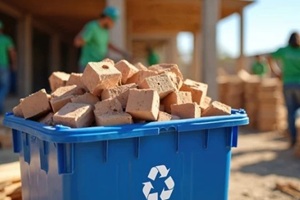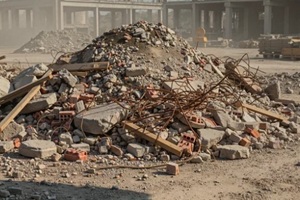
How to Manage Construction Waste on Any Jobsite
Any construction project, from a small-scale refit to a large-scale development, can produce a significant amount of debris. With the right strategic planning, jobsites can quickly organize this debris, separate hazardous waste, and dispose of it in compliance with local waste disposal laws. However, this requires working knowledge of how to maintain jobsite safety, manage costs, satisfy city ordinances, and maintain environmental responsibility while disposing of bulky and oftentimes dangerous construction debris.
This article walks through effective ways for jobsite managers to deal with construction debris, including sorting strategies and tips for problematic materials at each stage of the disposal process.
1. Identify Construction Debris

Construction debris can be created at any stage of a construction project, but those on a project may neglect to collect and sort every type of waste. Construction waste is not just the building and teardown materials themselves, but also any other materials left by the construction process, including:
- Surplus wood, such as extra framing scraps
- Off-cuts or broken panels of drywall and plaster, including dust
- Roofing materials, such as tar paper, flashing, and shingles
- Masonry, including cinder blocks, rubble, concrete, and bricks
- Organic waste, such as soil, rocks, and cleared vegetation
- Leftover plumbing and electrical materials, such as pipes and wiring
- Flooring material, such as carpet, laminate, tile, or padding
- Metal waste, such as studs, ducts, flashing, and vents
- Packaging materials, including material pallets, plastic wrapping, and cardboard
Everything created in the construction process, even wrappers and other trash from the workers’ breaks, is considered construction waste. However, not all waste is disposed of in the same way, making it essential for project leaders to classify it correctly.
2. Create a Construction Waste Management Plan
The plan should include an outline of how the construction waste generated during the project will be collected and stored prior to disposal, sorted for disposal, and removed from the site. Many general contractors require a waste management plan before signing off on the jobsite since they know that non-compliance with city disposal rules can put the project and the business in jeopardy.
An effective construction debris management plan includes these essential features:
- Projection for the volume and type of waste created by the project
- Planned collection points, including bin locations
- Dumpster sizes and locations, including the swap-out schedule
- Personnel designations for waste management
- Recyclable materials list
- Contingency plan for hazardous waste disposal
Even small construction projects need a construction waste management plan to improve jobsite productivity, cleanliness, and compliance. A proper plan leaves no room for surprises and no delays during collection or disposal.
3. Choose the Right Dumpsters

The right dumpster is essential to executing a construction waste strategy, including the right size and placement. Options include 10-yard, 20-yard, and 30-yard dumpsters, which are each ideal for different project sizes. When choosing a dumpster, consider the weight requirement and property access clearance. Many building materials, like shingles and concrete, hit maximum weight limits quickly.
Additionally, confirm dumpster placement restrictions based on city ordinances. Placing a dumpster on public property requires a permit, and jobsites can be fined for failing to follow disposal rules.
4. Know the Rules of Disposal
Throughout Virginia, materials labeled as hazardous or requiring special handling cannot be disposed of incorrectly. Placing these items in the wrong landfill or failing to properly classify them can result in fines or rejected pickups.
For example, wood, drywall, cardboard, concrete, brick, insulation, metal, wiring, shingles, and roofing materials are allowed in dumpsters with the local hauler’s approval. However, many of these items have special requirements.
While concrete and brick are permitted, their quantity and size must be carefully controlled or separated into multiple pickups to prevent dangerously heavy loads. Insulation cannot contain asbestos, or it must be classified as a hazardous material.
Other items that are prohibited or restricted due to hazards include:
- Propane tanks
- Pressurized containers
- Paint cans
- Solvents
- Tires
- Batteries
- Fluorescent bulbs
- Asbestos
- Liquid waste
- Food waste
- Pesticides
- Oil
Any liquids or gases with hazardous properties that could contaminate soil, water, or air are likely restricted. These items must be separated from the rest of the waste and diverted to the proper disposal facilities.
5. Recycle as Much as Possible
Many construction materials can be repurposed instead of thrown away. An efficient recycling plan can help jobsites reduce their disposal costs and environmental impact, while sometimes benefiting the contractor with reusable materials. Examples include:

- Clean wood can be reused or mulched.
- Scrap metal can be recycled for cash at processing plants.
- Concrete can be crushed for aggregate and used on future projects.
Many local haulers offer mixed-waste sorting, recycling, and other services that help contractors better manage demolition and construction processes. The goal is to recycle as much as possible, make extra profit where feasible, and prevent contamination on the jobsite.
Partner with a Local Waste Management Company to Manage Construction Debris on Jobsites of Any Size
At Full Strut Disposal, our team of waste management experts helps contractors and jobsite managers efficiently deal with their construction debris according to local regulations. From dumpster rental to material disposal, our team makes sure your jobsite remains compliant while sorting and disposing of any construction debris.
Contact our team today to avoid fines related to improper waste disposal and make your jobsite more efficient.



